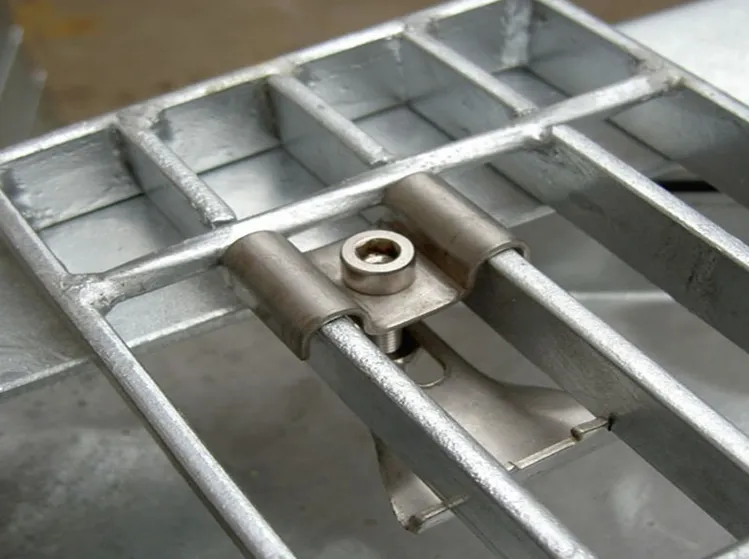Fiberglass Reinforced Plastic (FRP) grating systems are becoming increasingly popular across industries due to their corrosion resistance, low maintenance, and high strength-to-weight ratio. However, the performance and safety of FRP gratings depend not only on the panels themselves but also on how they are secured to supporting structures. That’s where grating clips come into play.
In this article, we’ll explore what grating clips are, their various types, key functions, and best practices for installation to ensure long-term structural stability and safety.

What Are Grating Clips?
Grating clips are mechanical fasteners designed to securely anchor FRP grating panels to supporting steel or concrete structures. These clips are critical to:
Prevent grating movement under dynamic load
Minimize vibration and noise
Ensure safety by keeping panels in place
Allow easy removal for maintenance or inspection
They are often made of stainless steel or coated carbon steel to ensure corrosion resistance in harsh environments such as marine, chemical, or wastewater treatment applications.
Types of Grating Clips for FRP
There are multiple types of clips available to suit different grating profiles, installation preferences, and structural conditions. The most common types include:
1. M Clips (Saddle Clips)
Design: U-shaped with a center bolt
Use: Secure two adjacent bearing bars to the support structure
Application: Heavy-duty installations or where vibration is a concern
Installation: Requires drilling into the support structure
2. C Clips
Design: Grabs two bearing bars together underneath
Use: Prevents uplift between adjoining panels
Application: High-traffic areas or modular grating systems
Installation: Bolts inserted from underneath
3. G Clips
Design: One-piece assembly with bolt, bottom clamp, and nut
Use: No need to drill or weld
Application: Fast retrofit jobs
Installation: Tightens from the top using hand tools
4. L Clips
Design: Single-point clip
Use: Ideal for smaller spans and lightweight panels
Application: Temporary or low-load environments
Installation: Fastened directly to substructure
5. T Clips
Design: Mushroom-style head
Use: Slots into grating openings
Application: Flush and clean surface finish
Installation: Tightened using hex or torque wrench
Functions and Advantages of Grating Clips
1. Anchorage and Load Distribution
Clips ensure the grating stays securely in place, especially under dynamic or shifting loads. Saddle clips (M-type) help distribute the load across the grating bars and support structures.
2. Uplift Resistance
In areas with strong wind, vibration, or water flow, clips prevent FRP grating from lifting or becoming dislodged.
3. Corrosion Resistance
Using stainless or hot-dip galvanized steel clips prevents rust and prolongs the structural life of the grating in corrosive environments.
4. Maintenance and Accessibility
Clip systems allow for non-permanent installation, which makes removal and reinstallation during inspections or system cleaning easier and cost-effective.
5. Vibration Minimization
Proper clip spacing and selection can help reduce rattling noises and structural vibration, improving the user experience in walkways and platforms.
Best Practices for Installation
1. Clip Spacing
Standard Rule: One clip per 1.2 meters of panel length and width
Minimum: At least 4 clips per panel
Heavy Loads: Increase clip frequency to avoid panel movement
2. Avoid Over-Tightening
Over-tightening the clips can damage FRP grating bars, especially pultruded types. Use a torque wrench to apply the manufacturer-recommended force.
3. Match Clip Type to Grating Type
Molded FRP grating requires clips that match the square mesh shape
Pultruded grating requires clips that align with its linear profile
4. Use Corrosion-Resistant Materials
In chemical plants, marine docks, or wastewater facilities, always opt for 316 stainless steel clips for best resistance.
5. Secure Corners and Panel Joints
Pay special attention to panel corners, mid-span joints, and edges — these areas are most prone to lifting or displacement.
Common Installation Mistakes to Avoid
Using the wrong clip type for the grating material
Omitting clips at high-stress points
Skipping periodic inspection of clip tightness
Improper alignment leading to grating warping
Using non-certified clips in corrosive environments
Applications of FRP Grating Clips Across Industries
Grating clips are essential wherever FRP gratings are used:
Oil & Gas Platforms: For walkways, stairs, and helipads
Wastewater Treatment: Corrosion-proof anchoring in wet zones
Chemical Plants: Secure placement in high-risk chemical spill areas
Marine Infrastructure: Docks, ship decks, floating platforms
Power Generation: Access platforms around machinery and turbines
Food & Beverage Processing: Hygienic, easy-to-clean installations
Maintenance Tips
Monthly Visual Checks: Ensure clips are in place and no signs of loosening
Semi-Annual Tightening: Re-torque clips as part of scheduled maintenance
Replace Damaged Clips Immediately: Especially in chemical environments
Keep Spare Kits: On-site clip kits ensure fast replacement when needed
Summary
Grating clips are small components with massive importance in FRP grating systems. Selecting the right type, installing them correctly, and maintaining them regularly ensures the structural safety, longevity, and performance of your FRP flooring system.
Whether you’re a plant engineer, construction manager, or a procurement specialist, understanding clip functions and best practices can help you reduce maintenance costs, enhance workplace safety, and ensure code compliance.


